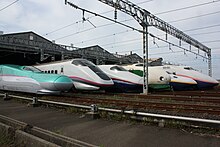JR East
|
Native name
|
東日本旅客鉄道株式会社 |
|---|---|
| Public KK | |
| Traded as | : : : 9020 |
| Industry | Private railway |
| Predecessor | Japanese National Railways (JNR) |
| Founded | 1 April 1987 (privatization of JNR) |
| Headquarters | 2-2-2 Yoyogi, Shibuya, Tokyo, Japan |
|
Area served
|
Kanto and Tohoku regions Niigata, Nagano, Yamanashi and Shizuoka prefectures |
|
Key people
|
Satoshi Seino (Executive Chairman) Masaki Ogata (Executive Vice Chairman) Tetsurō Tomita (Representative Director and President) |
| Products | Suica (a rechargeable contactless smart card) |
| Services |
passenger railways freight services bus transportation other related services |
| Revenue | |
|
|
|
|
| Total assets |
|
| Total equity |
|
| Owner |
Japan Trustee Services Bank (4.86%) The Master Trust Bank of Japan (4.11%) The JR East Employees Shareholding Association (3.33%) The Bank of Tokyo-Mitsubishi UFJ (3.16%) Sumitomo Mitsui Banking Corporation (2.66%) Mizuho Corporate Bank (2.53%) Mizuho Bank (2.47%) SSBT OD05 OMNIBUS ACCOUNT—TREATY CLIENTS (2.29%) Nippon Life (2.03%) Dai-ichi Life (2.02%) (as of 31 March 2013) |
|
Number of employees
|
73,017 (as of 31 March 2013) |
| Divisions | Railway operations Life-style business IT & Suica business |
| Subsidiaries | 83 companies, including Tokyo Monorail |
| Website | www |
|
Footnotes / references |
|
| East Japan Railway Company | |||||
|---|---|---|---|---|---|

Line up of JR East Shinkansen trains, October 2009
|
|||||
| Operation | |||||
| National railway | Japan Railways Group | ||||
| Infrastructure company | Japan Railway Construction, Transport and Technology Agency | ||||
| Statistics | |||||
| Ridership | 6.169 billion per year | ||||
| Passenger km | 130.5 billion per year | ||||
| System length | |||||
| Total | 7,526.8 km (4,676.9 mi) | ||||
| Double track | 3,668 km (2,279 mi) (49%) | ||||
| Electrified | 5,512.7 km (3,425.4 mi) (73.2%) | ||||
| High-speed | 1,052.9 km (654.2 mi) (14.0%) | ||||
| Track gauge | |||||
| Main | 1,067 mm (3 ft 6 in) | ||||
| High-speed | 1,435 mm (4 ft 8 1⁄2 in) | ||||
| Electrification | |||||
| Main | 1,500 V DC overhead catenary 2,680.3 km (1,665.5 mi) | ||||
| 20 kV AC, 50 Hz | 1,779.5 km (1,105.7 mi) Conventional lines in Tohoku Joban Line (Fujishiro-Iwanuma) Mito Line |
||||
| 25 kV AC, 50/60 Hz overhead | 1,052.9 km (654.2 mi) Tohoku Shinkansen (50 Hz) Joetsu Shinkansen (50 Hz) Hokuriku Shinkansen (50/60 Hz) |
||||
| Features | |||||
| No. tunnels | 1,263 | ||||
| Tunnel length | 882 km (548 mi) | ||||
| Longest tunnel | The Iwate-Ichinohe Tunnel 25,808 m (84,672 ft) Tohoku Shinkansen |
||||
| No. bridges | 14,865 | ||||
| Longest bridge | No.1 Kitakami River Bridge 3,868 m (12,690 ft) Tohoku Shinkansen |
||||
| No. stations | 1,703 | ||||
|
|||||
| Map | |
|---|---|
|
Shinkansen lines Conventional lines Greater Tokyo Area Network Map Suica and PASMO Network Map |
East Japan Railway Company (東日本旅客鉄道株式会社 Higashi-Nihon Ryokaku Tetsudo Kabushiki-gaisha?) is a major passenger railway company in Japan and one of the seven Japan Railways Group companies. The company name is officially abbreviated as JR-EAST or JR East in English, and as JR Higashi-Nihon (JR東日本 Jeiāru Higashi-Nihon?) in Japanese. The company's headquarters are in Yoyogi, Shibuya, Tokyo.
JR East was incorporated on 1 April 1987 after being spun off from the government-run Japanese National Railways (JNR). The spin-off was nominally "privatization", as the company was actually a wholly owned subsidiary of the government-owned JNR Settlement Corporation for several years, and was not completely sold to the public until 2002.
Following the breakup, JR East ran the operations on former JNR lines in the Greater Tokyo Area, the Tohoku region, and surrounding areas.
Its railway lines primarily serve Kanto and Tohoku regions, along with adjacent areas in Koshin'etsu region (Niigata, Nagano, Yamanashi) and Shizuoka prefectures.
...
Wikipedia
